From León |
|
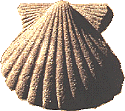
May 30 - León - Day 22Stops since last update: San Bol - Castrojeriz - Boadilla del Camino - Carrion de las Condez - Calzadilla de la Cueza - Sehagún - El Burgo Ranero - Mansilla de las Mulas - LeónDistance walked so far: 482 km - 298 milesTwo hundred kilometers have gone by smoothly since I last wrote. The official map says I have only gone 437 kilometers along the path, but I have taken a lot of detours to places along the way. The 482 I report above is about as accurate as I can be. The official map on my pilgrim's identification card (our passport to the pilgrim hotels) tells me I have 300 to 304 kilometers between me and Santiago. Now I am well over half the way along the Camino de Santiago. The days have become somewhat routine, as routine as days can become when you walk long through such varied landscapes. As the day begins, I remain in bed waiting for the gung-ho crowd to get up and scurry out by 6:30, a half an hour before the sun has even came up. They are gone by seven. I get up and leisurely pack my backpack, have an apple, orange, or banana, take my vitamins, and get on the road by eight. Once I start walking, I exercise my ankles, adjust my shoes (two or three times usually), and fairly quickly up work to my 4 kilometers per hour (2.6 mph). At the first bar (bars have coffee and food in addition to liquor) I stop for coffee with milk and a tortilla (This is an "omelette" not a Mexican tortilla) or bocadillo (sandwich on french bread). The tortilla is almost always a potato tortilla--it's a rare treat when I can get someone to make me a ham and cheese one. There is a small problem here: some days the towns are so tiny or so far separated that I do not get my morning coffee until I get to the town where I am going to stop--when I can anticipate that, I carry along fruit, raisons, and nuts (they are extra weight, so I only carry them when I must). Since I start out an hour after most have left, some days I see only three or four others most of the day along the path. When I leave with the pack, I am usually with the pack all day. My four kilometers an hour holds up for three or four hours, then I start to slow down. That's time for an hour or more siesta under some tree--when I can find one. But as the day gets on, whenever I happen on a bar I stop for something. I never know when it may be the last one I'll see before I get in for the night. The rest usually revives me so I can plod on more energetically to my resting place for the night--some town that has an alberge de peregrino--a pilgrim hotel where we'll be warehoused for the night in bunk beds that are sometimes three high. Most are very hospitable places. When the alberge is full, and they have been, we sleep on mats on sometimes very cold stone floors! Sometimes calling them "mats" is generous. Sometimes I can only move on to the next town or to a regular pensione or hotel or to some tree along the path (that hasn't happened to me yet, but it has to others). Some places are in tiny villages, like Boadilla del Camino, and others in huge cities, like this one in León, the third largest in Spain. 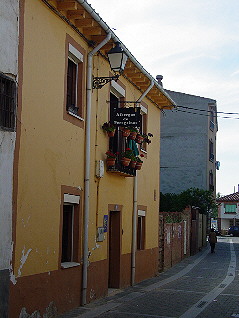 Every pilgrim's favorite site at the end of the day, the Pilgrim hotel. Only hearing, "yes, there is a cama (bed) for you," is better music to our ears. The day's trip usually is 20 to 25 kilometers (12 to 15.5 miles) though a few have been shorter, and one 32 kilometers (20 miles). My first activity at a new place is usually an hour's nap. That tends to get my feet and legs back in good order--they are treating me quite well these days. Sleep is followed by leisure time, defined as visiting the town, visiting with fellow pilgrims, writing notes, meditating, and eating something--many places have a "pilgrim's menu," a two course meal with wine and desert, well worth the 6 to 8 Euros it usually costs. Many places associated with churches have some evening prayers. In all, the light go off at ten. And so ends our day. Today's PicturesThis time I have grouped the pictures by subject. San Bol San Bol San Bol is a unique refugio in the high maseta sitting far out in the middle of nowhere in a grove of birch trees. Its ten beds and two mats assure no crowds gather. It has neither electricity or running water. The bathrooms are in the wheat fields below the spring. The weather was cool as I took my initial nap under a tree as the wind rustled the leaves. A spring there holds miracle waters: whoever washes their feet in it will have them cured. Not being one to thumb my nose at the fates, I washed my feet well and they have been doing quite well for me. I was last to arrive, number 11. I had the mat on a couch. No one else arrived to claim the other mat. Udo, the German volunteer who stays there till October, cooked a soup and lentil meal for all who paid the paltry 4 Euro for it. San Bol was a fine opportunity to retreat. The MasetaSpain's maseta is its equivalent of the U.S.'s Great Planes. Here they are a vast upland plateau, averaging around a thousand feet above sea level. I first encountered them west of Burgos where they are wild, rocky, semi-arid hills. They remind me a lot of North and South Dakota. Then they settle down to flatter land and finally become as flat as Kansas, Nebraska, and central Illinois. The maseta is the Spain's bread basket. I'm still on them in León and have many kilometers more to go. 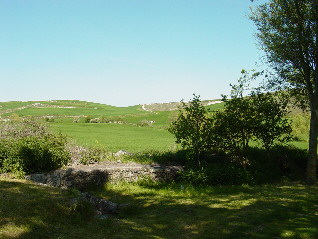 The Camino comes down a hill in the high maseta on its way to San Bol. This picture was taken from San Bol. 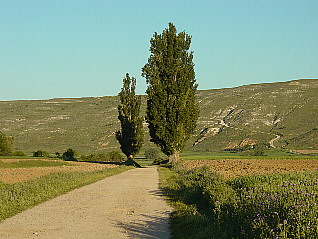 Leaving Castrojeriz, the Camino climbs one of the last big hills in the hilly part of the Maseta. 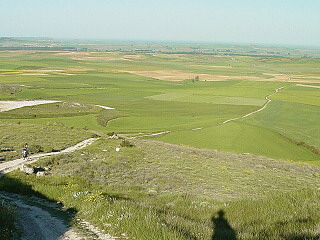 500 meters across a flat takes you to this view across the maseta. When you come in the fall it looks completely differently. 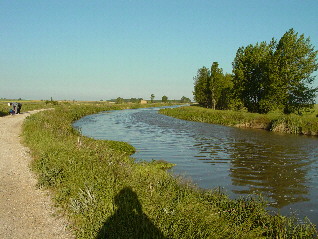 Canal de Castilla in the eastern side of the flat maseta. As in so many other places, Spain built a great canal system to carry freight a few tens of years before the train came to its own only to be replaced in turn by the truck. (Or are these for irrigation?) 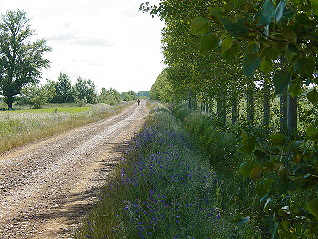 The Romans built this miles-long straight road across the maseta. Where chariots and soldiers passed for a few centuries, pilgrims now walk it as they have walked it for more than a thousand years. 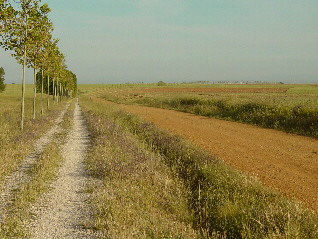 Maple trees mark the route of the Camino across the maseta west of Burgo Ranero ("Frogville"). Click here for another view of the path here. FlowersFlowers. Flowers. Flowers. Kings, heads of government, and Rajas of India could not have had more flowers thrown in front of them than I have had lining my way across Spain. What rainbows of color. Only the last few days have I really smelled them because my sinuses have been stuffed somewhat most of the time. Just look and enjoy. And now the blackberries and raspberries are beginning to flower--berries to eat in a couple weeks! [It never happened.] 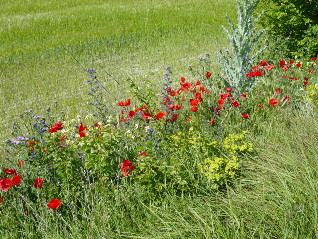 Along the road on the way into Castrojeriz. 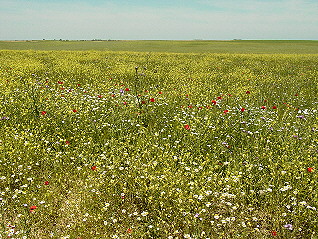 Along the road near Castrojeriz. 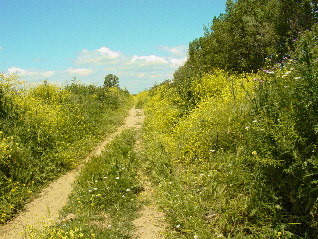 A path along a river burst into flowers over my head on both sides of the path. 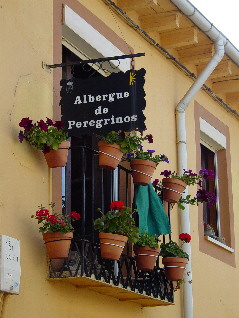 The ever present domesticated Geranium. These decorate the alberge in Mansilla de las Mulas. RuinsIn this country of centuries of history, many buildings, symbols of past grandeur, stand at various levels of destruction. Here are some. Fame is fleeting. 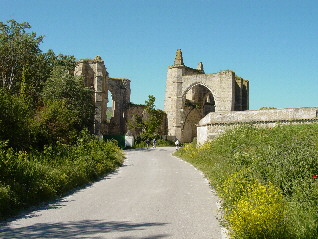 The ruins of St. Anthony's convent east of Castrojeriz. The order used the Greek letter tao (our T) as a symbol to protect 12th and 13th century people from St Anthony's Fire--a disease that rotted away extremities. The road goes through part of the ruins. 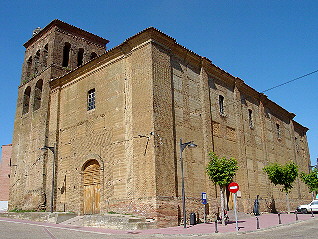 A Church in Sehagún has been converted into a pilgrims refugio and community center. Notice the stork's nest on the bell tower. Storks abound in this area. 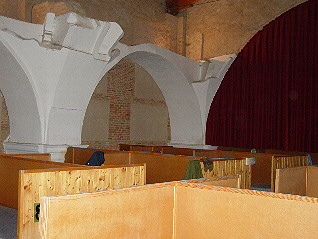 The top of top bunks in the refugio of this converted Sehagún church.  This Sahagún ruin is all that is left of what was once the strongest monastery in all of northern Spain in its time........ Bell TowersEvery town has it's church and bell tower. Here are just two that turned my fancy. 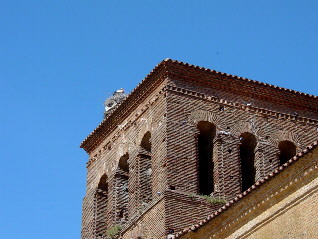 Here is a closeup of that Sehagún bell tower with stork--notice that they have incorporated a bed sheet into their nest. 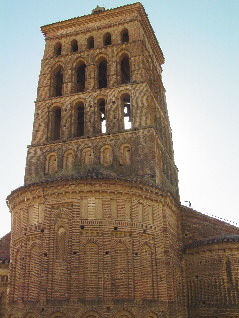 A rather elaborate bell tower in Sehagún. This one incorporates both christian and islamic building techniques. León CathedralLeón, the capital of the mighty Spain that sent Columbus on his way to the new world and in the same year drove the Arabs finally out of the Iberian peninsula. So 1492 has two important meanings here. León has a beautiful cathedral based on the cathedral in Chartres, France. I could not take pictures inside, but here are some from the outside. (Maybe they have a web site where you can see what the fantastically colorful and brilliant windows are like.) 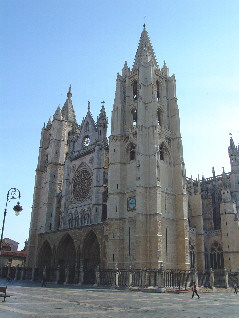 Front of the Cathedral of León. 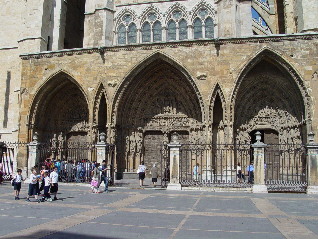 Front doors. 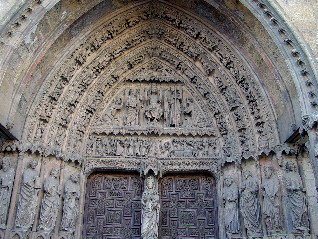 Details of the front doors. 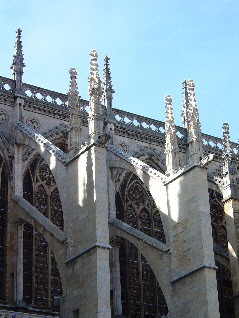 Buttresses.
Copyright copy; 2003-2012 Mike Metras, www.PilgrimageCreations.com | |

